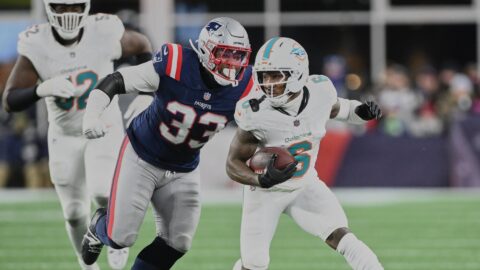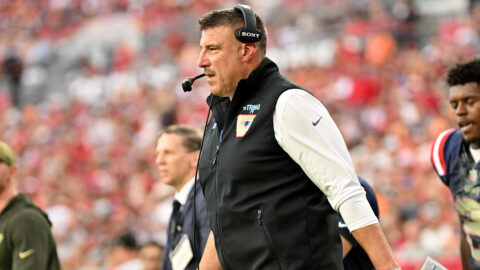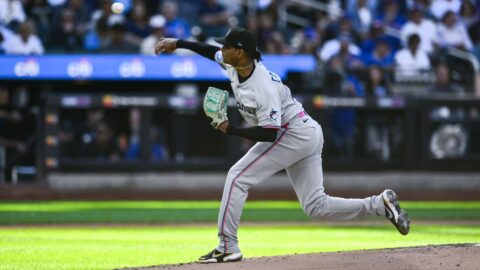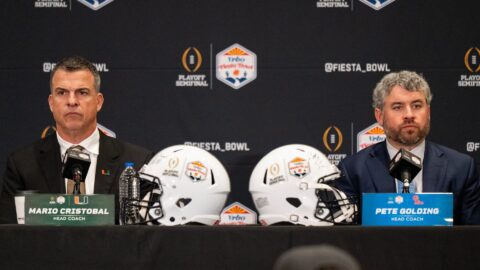The Red Sox finished their season Sunday at 89-73. It was an extremely unpredictable season, which will be followed by an extremely intriguing offseason. Before we begin looking ahead, here is a look back on how the team performed position by position.
Catcher (ranked in order of games played at the position): Victor Martinez, Jason Varitek, Kevin Cash, Jarrod Saltalamacchia, Dusty Brown, Gustavo Molina.
This year offered a transition at the catching position. While Martinez was with the club in 2009, this season was the first since 1999 in which Varitek did not come in as the starter. It also offered up perhaps the best offensive season for a Red Sox catcher since Carlton Fisk hit .315 with 26 homers and 102 RBIs in 1977, at least relative to the position.
Martinez led all major league catchers with 76 RBIs at the position and his 20 homers were tied with two others for the lead in that category. His phenomenal finish left him at .302 and he lost a month with a broken thumb, otherwise the numbers would’ve been even more impressive.
Varitek played in only 39 games due to a broken right foot. When in there early on he provided some pop, hitting seven homers in his first 22 games.
The bugaboo over the first month or so for Martinez and Varitek was throwing out base runners, a carryover from 2009 when the club was historically unsuccessful in such pursuits. But progress was made as the season went on and the catching corps ended up throwing out 20 percent of would-be base stealers. That was still among the worst marks in the league but considering that the tandem threw out just two of the first 37 runners way back in April, it was a vast improvement.
.273/.330/.463/.793 (2nd in American League), 27 home runs (tied 1st), 95 RBIs (1st)
Grade: A-
First base: Kevin Youkilis, Mike Lowell, Lars Anderson, Victor Martinez, David Ortiz, Jed Lowrie, Ryan Shealy, Niuman Romero, Jarrod Saltalamacchia.
Like a lot of positions this one might require an "Incomplete" when graded. When Youkilis was lost for the year in the early part of August, the Sox suffered a mighty blow. Youkilis was quietly building his best offensive season with a career-high .975 OPS and was his usual vacuum at first before tearing a muscle in his thumb and requiring season-ending surgery.
None of the replacements except maybe Anderson, who was very good with the glove in his short stint, could fill Youk’s void on defense. Only Martinez could come close with the bat, but he had zero homers and just three RBIs in 14 games at the position.
Youkilis deserves high marks for being himself while in there but the full season at first took a big with his departure.
.279/.371/.478/.849 (tied 4th), 24 home runs (7th), 84 RBIs (8th).
Grade: B
Second base: Dustin Pedroia, Bill Hall, Jed Lowrie, Marco Scutaro, Eric Patterson, Yamaico Navarro, Felipe Lopez, Niuman Romero.
The fact that eight different players appeared at second base this year says all you need to know about what went wrong. Pedroia missed just 13 games over the previous two seasons and was out of just two affairs in 2010 before breaking his foot in San Francisco on June 25 and managing just a two-game stint in August before being shut down.
Hall provided occasional pop at the position early on and Lowrie did so late, but like first base this was a position that suffered defensively as much as anything once Pedroia left. The former Gold Glover was having another remarkable year in the field. His departure was the point at which the team defense became ordinary.
.260/.332/.435/.767 (2nd), 22 home runs (3rd), 77 RBIs (3rd).
Grade: B+
Shortstop: Marco Scutaro, Jed Lowrie, Yamaico Navarro, Bill Hall, Angel Sanchez, Felipe Lopez.
Aside from third base this was perhaps the steadiest of positions until Marco Scutaro’s shoulder issues became too much for him to make the throw on a regular basis. And while the numbers of Scutaro and others won’t make anyone forget Cal Ripken or Ernie Banks, to call this a steady position for the Red Sox is saying plenty — shortstop had been a problem spot since Nomar Garciaparra was traded in 2004.
Scutaro will be 35 before the end of the month. Expect Lowrie to push him for playing time in 2011 and for hot prospect Jose Iglesias to make a step toward the big club in the minors.
.273/.334/.403/.737 (2nd), 16 home runs (4th), 70 RBIs (5th).
Grade: B+
Third base: Adrian Beltre, Jed Lowrie, Bill Hall, Yamaico Navarro, Kevin Youkilis, Felipe Lopez.
When Adrian Beltre was signed to a free-agent deal in January the only thing that excited some fans was the fact that it was a one-year deal (with options). Now most of those fans hope the club is able to retain Beltre for several more.
The team MVP was outstanding from start to finish, showcasing an all-out style at the plate and in the field that never waned, despite various physical ailments. His remarkable consistency gave this position the one true season-long stalwart. No injuries, no slump, no issues.
.321/.364/.554/.918 (1st), 31 home runs (2nd), 108 RBIs (2nd).
Grade: A+
Left field: Daniel Nava, Jeremy Hermida, Bill Hall, Darnell McDonald, Ryan Kalish, Eric Patterson, Jacoby Ellsbury, Josh Reddick, Jonathan Van Every.
The drama heading into the season centered on whether the shift of Ellsbury from center to left was the right move. Once he sustained broken ribs in a collision with Beltre on April 11, it was a daily drama just to fill the left field position.
Nava actually played more games there than anyone, all after a callup in June. Hermida was second, looking extremely lost in his 46 games in left. Hall, McDonald, Kalish and Patterson each played more games than Ellsbury in left. It was a revolving door that produced some meager production and a fair share of misadventures in the field.
.230/.303/.396/.698 (11th), 18 home runs (tied 7th), 77 RBIs (6th).
Grade: D
Center field: Darnell McDonald, Mike Cameron, Ryan Kalish, Jacoby Ellsbury, Eric Patterson, Bill Hall, Jonathan Van Every, Josh Reddick.
Like left field, there was incredible turnover at this position and some paltry final numbers, but at least there was reason to smile once in awhile. McDonald led the team in games played out there and his season as a whole was one of the bright spots in 2010, and Kalish’s emergence in the final two months was remarkable. He already has cemented his spot on the season-ending highlight reel with multiple leaping catches and two grand slams.
Cameron’s season was a disappointment. He played in only 46 games in center. In limited action he produced hits lowest OPS since 1998.
.234/.301/.381./.682 (12th), 14 home runs (8th), 62 RBIs (10th).
Grade: C-
Right field: J.D. Drew, Darnell McDonald, Josh Reddick, Bill Hall, Jeremy Hermida, Jonathan Van Every, Ryan Kalish.
If you were told before the season that the Red Sox’ outfield would involve a constant rotation of players you might think that Drew would have his physical issues. But he was the most durable of the crew, playing in 133 games in right and going without an error until the season’s final day.
Drew endured a difficult summer at the plate but a late power binge (10 homers in his last 39 games) put his numbers closer to his Red Sox norms.
.269/.345/.456/.801 (6th), 25 home runs (5th), 84 RBIs (9th).
Grade: C+
Bench: You name ‘em, they sat there.
The Red Sox used three more position players (43) than anyone else in the American League and seven more than the average, due entirely to the injuries. Several of the aforementioned players would spend multiple days on the bench while also starting at multiple positions all in the same week.
McDonald was the best of the lot, providing the ability to come off the bench to steal a base or put down a bunt (he was second on the team in steals and first in sacrifice hits). He also hit .429 (6-for-14) with a home run in pinch-hitting roles. That helped Boston lead the league in batting average for pinch hitters, posting a .265 mark.
.239/.319/.358/.677, four home runs, 34 RBIs.
Grade: B+
Starting Pitching: John Lackey, Jon Lester, Clay Buchholz, Daisuke Matsuzaka, Josh Beckett, Tim Wakefield, Felix Doubront, Scott Atchison.
Injuries did hit the rotation but not nearly to the degree that they hit other positions. Unfortunately the inconsistency never allowed what figured to be a top-notch staff to establish itself.
The Sox’ starters did lead the league in strikeouts by a wide margin with 833 and had a better ERA (4.17) than two playoff teams, New York and Texas. It also was third in innings pitched and one of just four staffs to record as many as 70 wins from its starters alone.
Lester and Buchholz were All-Stars, Lackey had the biggest workload and led the team in quality starts (21) despite some ups and downs, but Beckett and Matsuzaka were major disappointments. While some of the numbers previously mentioned signal a pretty strong group overall, the degree to which potential was unrealized makes for an off year overall.
70-50, 4.17 ERA (6th), .254 batting average against (4th)
Grade: C+
Bullpen: Daniel Bard, Jonathan Papelbon, Hideki Okajima, Manny Delcarmen, Ramon Ramirez, Scott Atchison, Dustin Richardson, Scott Schoeneweis, Michael Bowden, Tim Wakefield, Robert Manuel, Felix Doubront, Joe Nelson, Robert Coello, Rich Hill, Boof Bonser, Matt Fox, Fernando Cabrera, Jonathan Van Every, Bill Hall.
Only Kansas City used as many pitchers this year as the Red Sox (25). Bard was the best of the bunch and Papelbon had two long dominant stretches mixed in with some ugly blown saves. Beyond that it was a constant search for guys who could get consistent outs.
The team opened up competition in spring training for the No. 3 reliever ahead of Bard and Papelbon, and also for the last spot of the bullpen. While Atchison eventually won the latter contest and ran with it, the bridge to the back end continuously failed.
No A.L. bullpen gave up more home runs than Boston’s 63. The same goes for opponents’ OPS, which came in at a .743 clip vs. the Red Sox relievers. Only Baltimore had more blown saves than the 22 put forth by Papelbon and others.
19-23, 4.25 ERA (12th), .250 batting average against (5th).
Grade: D+
Coaching: DeMarlo Hale, John Farrell, Tim Bogar, Ron Johnson, Dave Magadan, Gary Tuck, Rob Leary.
Hale was in his first year taking over for the highly respected Brad Mills. Like Mills, Hale is manager material and may get his shot someday. The same goes for Farrell.
Magadan deserves loads of credit for helping engineer the majors’ second-best offense with a collection of replacements and minor leaguers. Tuck gets the same for helping to turn around the catching defense that was exploited early on.
Bogar, also in his first year as the third base coach, had a few notable mistakes early in the season when he was overly aggressive. Those situations were few and far between in the second half.
Grade: B
Manager: Terry Francona.
He has never finished higher than fourth in the A.L. Manager of the Year voting, but Francona will get some consideration this year for the way in which he helped the club stay the course.
Although players and coaches will not use it as an excuse, the injuries were likely just too hard to overcome. That said, the fact that the Sox were not mathematically eliminated until the final week of the season while playing in the best division in baseball says something about Francona’s work.
He took plenty of blame for the slow start as he struggled to mix and match the new roles for several players. The 11-14 opening set the tone in a lot of ways as Boston was always playing from behind.
Aside from that, Francona was exemplary.
Grade: A-
General Manager: Theo Epstein
There were moves that worked well (signing Beltre and Scutaro, promoting McDonald and Kalish), some which were a mixed bag (Lackey) and others which failed (signing Cameron, moving Ellsbury to left), but the moment that most will look back on as the signature one for the front office was when it was unable to fix the bullpen through either a trade or from within the system.
Epstein said that was not from lack of effort, and is quick to point out that the few relievers that were moved did little to affect playoff races. Essentially, it came down to the Sox not wanting to part ways with certain prospects for a pitcher that may or may not have helped them get in the playoffs. If said prospects develop, which would be the culmination of Epstein’s "bridge" concept, it was a brilliant bit of restraint. If not, some will continue to wonder if another quality arm or two in the bullpen could’ve saved the season.
The 2009-10 offseason and the 2010 season had its positives and negatives from a front office perspective. Epstein truly will be judged on this offseason perhaps more than any other.
Grade: C+
Overall:
When the definitive story of the 2010 season is written it will be hard for the author to not use the word "injuries" in the first paragraph. It tells so much of the tale. The second paragraph will use words like "resiliency" and "gutty" and "overachieving." Recent Red Sox teams are used to more powerful adjectives than that.
Grade: B-



